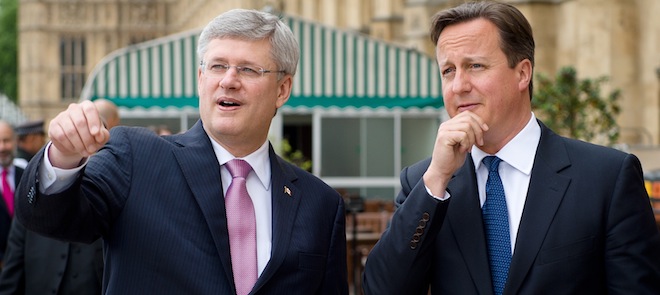PM Harper uses star turn in London to tout free trade
Katie Engelhart reports from the Queen’s Robing Room
British Prime Minister David Cameron, right, talks with his Canadian counterpart Stephen Harper ahead of Prime Minister Harper’s address to the House of Commons in central London, Thursday June 13, 2013. (AP Photo/Leon Neal, Pool)
Share

The Queen’s Robing Room, which back to 1834, is, as the name implies, used to robe and crown the Queen for appearances before the House of Lords.
On Thursday, it was the site of Prime Minister Stephen Harper’s address to the British Parliament in London—the first by a Canadian leader since William Lyon Mackenzie King in 1944, just weeks before D-Day. Harper opted for a dark suit and decided un-regal pinkish tie: no robe, no crown. (When Queen Elizabeth is not being dressed, the room is sometimes used to host foreign leaders.)
Harper’s address kicked off his eight-day tour of Europe, which will end with the G8 summit in Northern Ireland. His speech, accordingly, included numerous appeals for unbending resolve, seven to Winston Churchill and 23 to “values.”
Cameras were permitted, but the media was sternly warned not to photograph the Queen’s throne—which rests along a back wall, and which was looking rather worse for wear, with its dingy velvet upholstery worn through in several places.
We journalists busied ourselves with copies of the speech, which included pronunciation reminders for the PM. (The Duke of “Ed-in-burra.”) The High Commission had warned us to dress nicely for the occasion.
“I’m a backbencher!” announced a sprightly, 70-something British man standing near the press pack. Indeed, he was Lord Charles Lyell, a Conservative politician who first joined the House of Lords in 1960. Lyell fit right in, with a crowd almost entirely composed of silver and white-haired gentlemen—all gathered, presumably, to hear Stephen Harper peddle his vision for a Canada-EU trade deal.
When pushed, Lyell said he hoped to hear Harper discuss “ah… defense”—and also perhaps the NHL. “I follow many of your skiiers and hockey players,” he noted, before inquiring: “Why exactly is [Harper] here?”
The man himself arrived in the room around noon, shortly after British Prime Minister David Cameron, who appeared bronzed, following a recent vacation to the Mediterranean party island of Ibiza. Britain’s Rt. Hon. John Bercow introduced Harper, describing Canada as “a country of unassuming optimism.” The broadcast journalists lining the wall hissed at the print journalists to get out of the way.
And then the address, which lasted roughly 30 minutes. Harper was effusive in praising his hosts: “There is no honour to compare with an invitation to stand here at the very cradle of our political system.” He earned several cheers: once, after expressing best wishes for Duchess of Cambridge Kate Middleton, who is expecting a baby next month—and another time, for a coy reference to the British comedy series “Yes, Prime Minister.”
He also won spirited applause for a carefully worded reference to Britain’s sovereignty dispute with Argentina over the Falkland Islands. “We have also clung jointly to our values in the South Atlantic, supporting the right of free people living on small islands to determine their own future.”
“Here, here!” an audience member called out.
But not all moments were cheery. Harper spoke of present circumstances North Korea (“a Cold War totalitarian state), Iran (“a profoundly malevolent regime”) and Syria (“decent people agree that Assad must go […] yet the extremist, Sectarian nature of much of the opposition cannot be ignored or wished away.”)
He also lingered on the “unrelenting hostility” faced by Israel, and “the moral relativism in so much of world affairs that provides shelter to such anti-Semitism.”
A key moment was Harper’s much-anticipated plug for free trade. The PM has been negotiating a Canada-EU trade deal for the last four years, but talks have stalled.
Winding down his address, Harper suggested that Canada and Britain could look to “the example of Mrs. Thatcher” for guidance through troubled times. UK Labour leader Ed Milliband looked stoically on.
Leaving Westminster, the pack of reporters following Harper on his G8 tour were shepherded onto buses, by a gaggle of well-heeled Canadian High Commission employees.
Wandering off to the tube station, I was approached by Jess Worth of the UK Tar Sands Network, who reported that protesters had gathered several blocks away to demonstrate against Canada’s oil sands development. “There were also direct action protests.”
Police, evidently, had been prepared. London officers arrested five Harper protesters on Thursday. Two women wearing “Stop Harper” and “Respect Indigenous Rights” t-shirts were apprehended after they smeared oil on their faces and attempted to chain themselves to a gate.
Worth was unfazed by the episode. “Look, we’re on Twitter!” she said. And then the two of us bent over her iPhone, leaving two surly security guards to wash oil off the pavement.